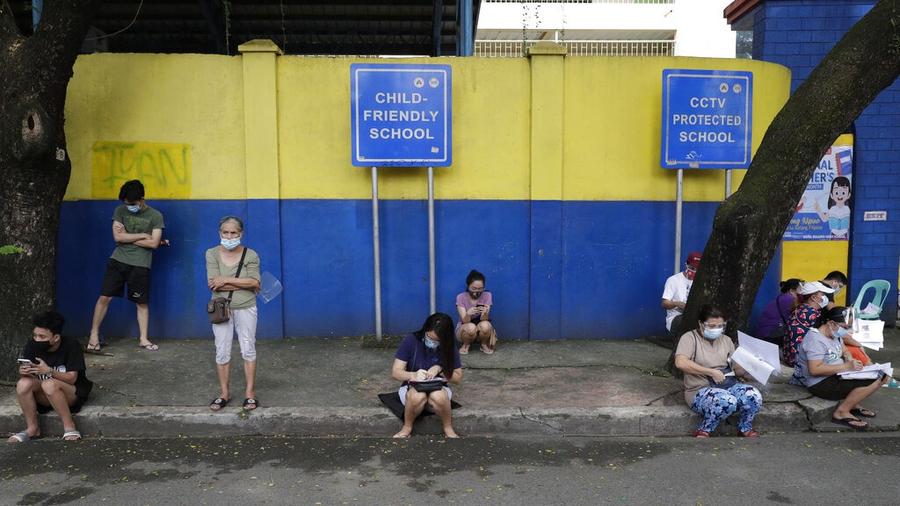- Chinese jabs welcomed in bid to turn back virus
- Battered Philippines gears up for shots drive
- Oxford's vaccine found to cut spread
- Africa's rollout gathers pace as more doses arrive
- Case for 2 masks builds in US, Fauci says
- UK snow stars wait for Beijing golden day
- UK, EU fall into fresh row over N. Ireland
 People wearing masks and face shields practice social distancing while waiting for their turn to pick up student electronic tablets ahead of online classes which are scheduled to start next week, in the Dona Rosario High School in Quezon city, Philippines, on Oct 1, 2020. (AARON FAVILA / AP)
People wearing masks and face shields practice social distancing while waiting for their turn to pick up student electronic tablets ahead of online classes which are scheduled to start next week, in the Dona Rosario High School in Quezon city, Philippines, on Oct 1, 2020. (AARON FAVILA / AP)
The Philippines is planning a mass inoculation drive by the end of this month to curb coronavirus infections and revive an economy reeling from its worst post-World War II slump.
President Rodrigo Duterte said in a televised briefing on Monday that while the economy is "sinking deeper and deeper", the government is trying its "very best to keep (it) afloat".
Around 3 million vaccine doses are expected to arrive this month, said Carlito Galvez Jr, who heads the nation's COVID-19 task force. The vaccines are coming from the COVID-19 Vaccines Global Access Facility, or COVAX.
The Philippines secured 25 million doses of the Sinovac-developed CoronaVac vaccine.
ALSO READ: Philippines eyes China, Russia for early vaccine access
The Philippine economy contracted by 9.5 percent in 2020, the worst performance since 1946, official data showed.
Analysts say the vaccine rollout is crucial to lift household consumption, which accounts for roughly 70 percent of the country's GDP.
The National Economic and Development Authority, the economic planning agency, said lockdown measures and mobility restrictions may have slashed household spending by 801 billion pesos (US$16.74 billion) in 2020.
Recovery is definite but not necessarily going back to the high growth path prior to COVID-19.
Alvin Ang, professor of economics at the Ateneo de Manila University
"Recovery is definite but not necessarily going back to the high growth path prior to COVID-19," said Alvin Ang, professor of economics at the Ateneo de Manila University. "The challenge is still balancing public health and the national economy".
The Philippines has one of the highest number of COVID-19 cases in Southeast Asia, with infections at more than 525,000 and the number of deaths at more than 10,000.
Duterte said "the only salvation" for those who have not been infected is to follow the health protocols imposed by the government.
Before the pandemic, the Philippines had been one of the world's fastest-growing economies.
Rajiv Biswas, Asia Pacific chief economist at global business information provider IHS Markit, said vaccines are needed to contain the pandemic, boost consumer spending and buoy the broader economy.
Perspectives vary
"The Philippines economy is forecast to show a strong economic recovery in 2021, with GDP growth of 7.7 percent year-on-year. This economic rebound will be supported by the gradual rollout of the COVID-19 vaccination program," Biswas said.
Nicholas Antonio Mapa, senior economist for Dutch investment bank ING, has a less sanguine view. He expects the Philippine GDP "to remain in contraction" in the first quarter of 2021 before posting a substantial 13 percent rise in the second quarter.
"Household spending, the main growth engine of the economy, will likely stay in low gear with the unemployment rate at 8.7 percent, with prospects for a quick turnaround in consumption confounded further by the return of inflation," Mapa said.
Karl Kendrick Chua, the Philippines' acting socioeconomic planning secretary, said in a Jan 28 briefing the reopening of businesses and wider accessibility of public transport will "lead to a strong recovery before the end of the year".
READ MORE: China, Philippines agree to boost cooperation against pandemic
Contact the writer at prime@chinadailyapac.com


